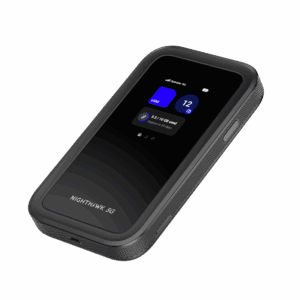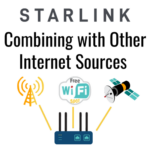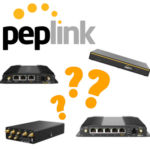Key Points:
- The Netgear Nighthawk 5G M7 is an eSIM-first global hotspot designed to connect in 140+ countries, priced at $499.
- The new hotspot uses the Qualcomm X72 modem, the little brother of the X75 used in the Nighthawk M7 Pro.
- This hotspot is a departure from previous Netgear hotspots, with a different form factor, eSIM support, and a data-plan lineup in a new Netgear App.
- Netgear is also releasing a "home cradle" dock for M6 and M7 series hotspots, offering Ethernet ports, a cooling fan, and other features.
Netgear today announced a new 5G mobile hotspot - the Netgear Nighthawk 5G M7, which is expected to be available for purchase on January 27th, 2026, for $499.99 MSRP.
While we have been anticipating another hotspot in the M7 series lineup to complement the AT&T-exclusive M7 Pro released over a year ago, we're surprised at just how different this new M7 (model MH7150) is.
Rather than follow the same basic design of the Nighthawk hotspot line-up from the previous generations and the M7 Pro, Netgear has made a fundamentally different kind of mobile hotspot, one that comes with new capabilities and benefits, but also some compromises.
So what, exactly, is different? Let's dig in.
Table of Contents
Nighthawk 5G M7: A New Form Factor
The first, and most obvious, difference is the form factor. The new M7 has a rectangular design with no touchscreen, unlike previous Netgear hotspots, which were square and touchscreen-enabled.
Here's a size comparison between the new M7 and the M7 Pro. Overall, the M7 is roughly the size of a plus-sized smartphone, but thicker and heavier. It's 3.29 x 5.71 x .67 inches and a half-pound in weight:

Netgear tells us the new form factor is more pocket-friendly, being narrower and taller. It also allows for a more optimized internal antenna design.
The device does have a screen, but it is not a touchscreen or interactive. The new M7 is designed to work with a redesigned Netgear mobile app, which is an integral part of controlling the hotspot.
Some other form factor changes include:
- The absence of external antenna ports. Traditionally, Netgear included 2x TS-9 ports for external antennas on hotspots, but not on this new M7.
- No Ethernet port. However, the new M7 can be used with a standard USB-C-to-Ethernet adapter, and Netgear will sell one as an accessory.
- No removable battery. One long-standing feature of Netgear mobile hotspots has been not only a removable (and easily replaceable) battery, but also the ability to use the hotspot without a battery. The battery in the new M7, by contrast, is not removable, but complies to "right to repair" and has a removable back cover to allow for battery replacement. Netgear says the device should have about 10 hours of battery life with regular use.
The Netgear Mobile App

Another significant change is in how the hotspot is managed.
Traditionally, you have to connect to the hotspot with a phone or computer, then enter an IP address or a web address to access the device's firmware. Flagship devices tend to have a small touchscreen for basic controls.
With the Nighthawk 5G M7, Netgear has moved away from that toward an app-centric system, what Netgear calls "app first," in which the hotspot is paired with a smartphone and the device is managed through the Netgear mobile app. Netgear tells us you can configure all settings via the app, but you can also access the firmware and on-device WebUI directly, the traditional way, if needed.
Netgear tells us this is not only to enable eSIM support, but also to make using the hotspot a lot simpler and more straightforward for non-technical users.
Another major upcoming change to the Netgear mobile app is support for Netgear's own eSIM data plans. The app will include a Netgear eSIM store called the "NETGEAR eSIM Marketplace" that lets customers easily purchase a data plan for the device.
Netgear says data plans ranging from 3GB to 20GB will be available, and that customers can manage usage in real time. As a global device, Netgear's marketplace will have individual country and region options for 140 supported countries, similar to other global eSIM options. Pricing has not been published yet.
At press time, the Netgear Mobile app has not been updated with the new features.
Technical Specifications
 The heart of any mobile hotspot device is the cellular modem. Here, the Nighthawk 5G M7 uses the Qualcomm X72 modem, the little brother of the X75 that powers the M7 Pro.
The heart of any mobile hotspot device is the cellular modem. Here, the Nighthawk 5G M7 uses the Qualcomm X72 modem, the little brother of the X75 that powers the M7 Pro.
Similar to the difference between the Qualcomm X62 and X65, the X72 is a lower-cost version of the X75 with lower peak performance. The X72 and X75 are from the same generation, share the same AI engine, and are both 5G Advanced-ready.
The key difference is that the X75 supports more carrier aggregation (5x vs 3x) and a higher total bandwidth (300 MHz vs 200 MHz), which is the primary factor behind its higher performance.
Despite a lower peak performance than the M7 Pro, having the X72 in this new M7 is not a significant downside, especially with today's cellular networks. It's still an improvement over the X65 and X62.
Netgear says the max theoretical speed for the new M7 is 4 Gbps compared to 6 Gbps with the M7 Pro. Those peak speeds will never be seen in real-world usage, but the X72 in the M7 will have plenty of headroom to grow as carriers deploy more 5G Advanced-capable towers.
Here are the bands supported for the US/Canada version of the device:
- 5G Sub6: n1, n2, n3, n5, n7, n12, n13, n14, n25, n26, n28, n30, n38, n41, n48, n66, n70, n71, n77, n78
- 4G LTE: 1, 2, 3, 4, 5, 7, 12, 13, 14, 17, 25, 26, 28, 30, 38, 41, 42, 43, 48, 66, 71
This will work very well for all North American carriers and supports almost all the major global carrier bands. For international use, it is only missing LTE Band 20, used in rural areas of Europe, and Band 8/n8, used in parts of Europe, Asia, and Africa. The omissions are disappointing but not significant enough to affect international roaming in most cases. There is also a European/Asia version of the M7 that supports these two bands, but that model lacks support for several important US bands and won't be sold in North America.
This device also doesn't support millimeter wave 5G bands. We don't consider this a major downside, as mmWave is not widely deployed, and adding that capability increases complexity and expense to any device.
WAN Options: eSIM, SIM, & Wi-Fi-as-WAN
 Netgear told us they consider the new Nighthawk 5G M7 an "eSIM-first" device, meaning it's primarily intended for use with an eSIM data plan. The hotspot itself can store up to seven eSIM profiles.
Netgear told us they consider the new Nighthawk 5G M7 an "eSIM-first" device, meaning it's primarily intended for use with an eSIM data plan. The hotspot itself can store up to seven eSIM profiles.
What's nice about Netgear's system, compared to almost every other global eSIM hotspot and provider, is that the M7 isn't restricted to Netgear's marketplace plans. Customers can also purchase eSIMs from other providers and load them onto the hotspot via the Netgear mobile app.
Additionally, there is still a physical nano-sized SIM slot, allowing use of more traditional, non-eSIM plans. This is especially important because the three major US carriers have been slow to provide eSIM options for data-only devices other than tablets. There are currently no other eSIM hotspots compatible with US carriers, and only a handful of mobile routers support the feature.
Combined, this gives the new M7 a lot of flexible, convenient, and future-proofed plan options, more than is available from a traditional hotspot and most routers.
Finally, the M7 can also connect to Wi-Fi access points via Wi-Fi offloading. Netgear has included Wi-Fi offloading as a feature for many years, but now it's a more integrated option that lets the hotspot act like a travel router, offering limited Wi-Fi-as-WAN capability. Your devices still connect to the M7, but the M7 can use public, campground, or marina Wi-Fi as a connectivity source to save cellular data. We don't yet know, however, how easily the device can navigate through captive portals.
While this is a great feature, expect a significant performance penalty, as the hotspot's Wi-Fi radio will need to do double duty, servicing both the WAN and any connected LAN clients. Once we have an evaluation unit, we'll test how well this works in reality.
M7 LAN Connectivity
 The M7 features Wi-Fi 7, which Netgear says has a peak throughput of 3.6 Gbps and supports up to 32 devices. However, unlike the M7 Pro, the new 5G M7 does not support the 6GHz frequency band. Wi-Fi 7 is only supported on the 2.4 and 5 GHz bands.
The M7 features Wi-Fi 7, which Netgear says has a peak throughput of 3.6 Gbps and supports up to 32 devices. However, unlike the M7 Pro, the new 5G M7 does not support the 6GHz frequency band. Wi-Fi 7 is only supported on the 2.4 and 5 GHz bands.
While it's disappointing that 6GHz support is absent, the omission isn't uncommon, as the FCC has special restrictions on using the band outdoors, and it tends to draw a lot of power. Additionally, the hotspot doesn't support Wi-Fi 7's MLO (Multi-Link Operation) standard, which allows combining frequency bands. The M7 should still provide good Wi-Fi performance, however.
The other connectivity option is USB, via a USB-C port. The USB port supports up to 5 Gbps transfer speed and also serves as the charging port. Netgear didn't provide a list of compatible devices, but it's likely that it can be directly connected to laptops and, hopefully, routers that support USB tethering. Once we receive an evaluation unit, we'll test to see if there are any USB tethering limitations.
Additionally, the M7 can act as a battery bank for other devices.
Ethernet connectivity is supported via a USB-C-to-Ethernet adapter instead of a dedicated Ethernet port. Netgear will sell a dedicated adapter as an accessory for the M7, which includes a charging port, but Netgear told us most any USB-C-to-Ethernet adapter should work fine. Netgear says the peak Ethernet speed with an adapter is 2 Gbps, which is plenty fast.
Netgear Home Cradle

Along with the 5G M7 hotspot, Netgear will also release a cradle system compatible with the M6 and M7 series mobile hotspots, including the M7. It's also compatible with the old M3 hotspot. This is an option we've not seen in over a decade for mobile hotspot devices.
The Netgear Home Cradle has two Gigabit Ethernet ports, expanding wired connectivity options. Ethernet can be further extended by adding an Ethernet switch. Another great feature is its integrated cooling fan, which keeps the hotspot cool when docked.
It's also compatible with the M7 Pro's high-performance mode and can dock without a battery for long-term use (for models with a removable battery).
The cradle has channels and holes that allow you to use a hotspot's external antenna ports (for compatible models with ports).
Additionally, the cradle can serve as a failover for another internet connection. It's designed to sit between a cable/fiber modem and a router - if it detects an outage from the primary WAN connection, it will fail over to use cellular data from the docked hotspot. While not as useful for mobile users with cellular routers, it's a nice feature for a more traditional landline internet setup.
Overall, it's really great to see cradles make a comeback, and this one is particularly useful and could be a good addition for anyone who has an M6 or M7 series mobile hotspot device. Unfortunately, at press time, we don't have the expected MSRP price from Netgear, and it's not currently shown on the Netgear website.
Member Exclusives Below:
Bonus Member Only Content Available!
We go extra for our premium members - who make this resource center possible (did you notice the lack of 3rd Party advertising?). We have included some additional information in this news article just for our members - analysis, guidance and/or insider tips.
If you're not yet a member, please consider joining us. Extra content like this is one of the many perks we offer - in-depth content, guidance, discounts, alerts, classroom and more.

If you are already a member, please log in above to see the special content we have prepared for you.
Concluding Thoughts
The mobile hotspot market has, for many years now, offered only iterative updates that feature the same basic functionality. With the Nighthawk 5G M7, Netgear is trying something new: A global mobile hotspot that can be used with almost any hotspot-compatible data plan, including Netgear's.
We've seen and covered global mobile hotspot devices and plans for years now, but none have been particularly attractive due to low-end hardware and restrictive, proprietary data plan options. Netgear has made this segment interesting again with a global hotspot that features an advanced modem and perhaps offers the most complete and flexible data plan array of any mobile hotspot to date, thanks to eSIM plans available from Netgear and third parties, as well as traditional physical SIM options.
At least on paper, this new hotspot looks to be an interesting and compelling option to consider.
Netgear will provide us with an evaluation unit in January, and we'll test these capabilities and also compare the new M7 with the M7 Pro to see how well it actually performs. Our members, as always, will have access to all our detailed testing and evaluation information, in addition to the other perks of membership.
Further Reading
- Understanding & Selecting Mobile Hotspot Devices (MiFi, Jetpacks, AirCards) - Our featured guide evaluating the various ways to get online while mobile, including using mobile hotspots.
- Review: Netgear Nighthawk M7 Series Mobile Hotspots
- Overview: Netgear Home Cradle For Mobile Hotspots (coming soon)
- All Our 5G Cellular Resources
Related News:








 Mobile Internet Resource Center (dba Two Steps Beyond LLC) is founded by Chris & Cherie of
Mobile Internet Resource Center (dba Two Steps Beyond LLC) is founded by Chris & Cherie of